Raptors can be ingenious in adapting their hunting techniques and available skills to the terrain they are hunting and this juvenile Sharp-shinned Hawk was a perfect example of such flexibility. Though I never did photograph the bird in the process of hunting in flight I’ll do my best to describe its technique using photos as I describe what I observed.
First, let me set the stage.
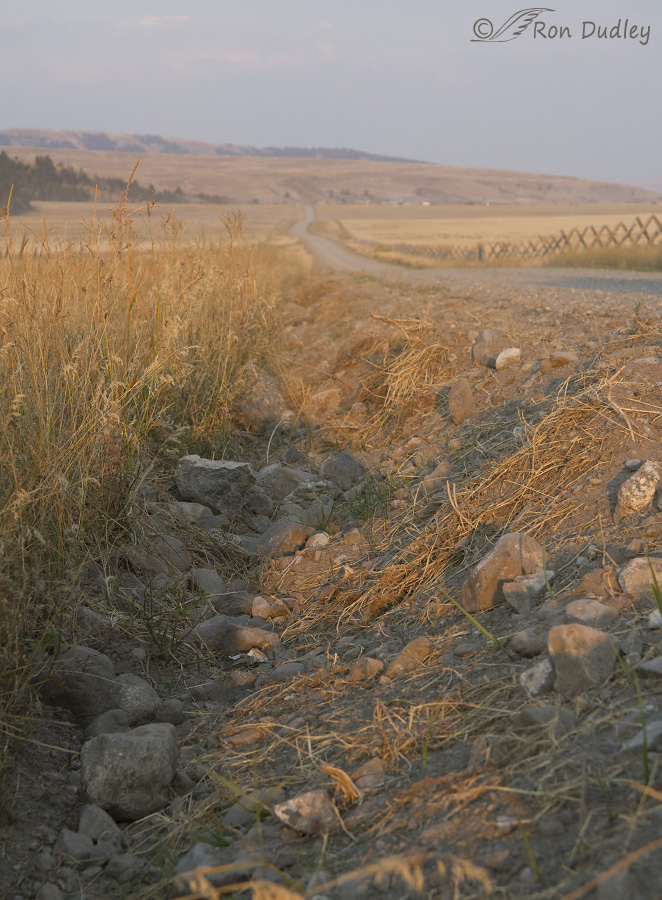
The almost 30 mile long South Road in Montana’s Centennial Valley is notoriously rough but it has been much improved in recent years as it has been regularly graded, elevated and smoothed out. In the process graders typically tilt their blade at an angle of about 45 degrees along both road edges which creates a very steep and narrow trough along the side of the road (which can make turning around for a bird in a full-sized pickup a real adventure…). In most places the trough is narrower and steeper than this but I didn’t think to take photos of those areas. Sorry about my shadow in the photo, I couldn’t avoid it…
Soon after dawn on my first morning in the valley last week I found a juvenile Sharp-shinned Hawk hunting this trough for small birds. It had been 14 degrees just a few minutes earlier so the birds were hunkered down along the edge of the vegetation and the Sharpie was hungry after a long, cold night. I watched as the hawk flew low and slow in this trough along the length of the road in its attempt to ambush birds. It was flying so low in the wedge-shaped trough that it couldn’t fully extend its wings but even so I was blown away by how slow it was able to fly.
The hawk hunted the trough in front of me for about a quarter-mile as I slowly drove the road and watched the technique in amazement. It would occasionally stop to rest and it was only during those times that I was able to get any photos of the bird. On this morning I didn’t see it catch any birds but just watching it hunt using that technique for that long was something I won’t soon forget.
Following are some of the photos of the hawk I was able to get during its rest stops.
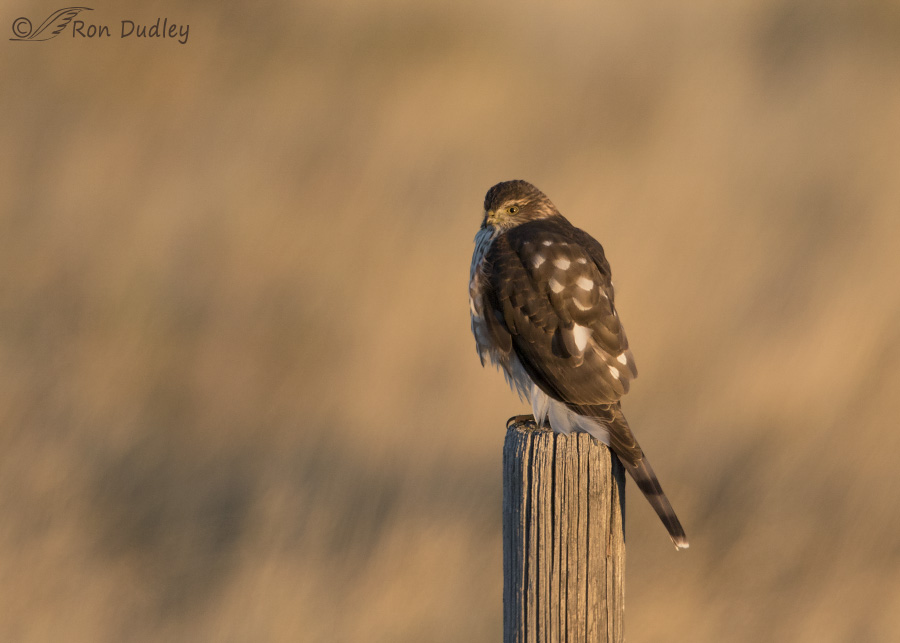
1/400, f/6.3, ISO 500, Canon 7D Mark II, Canon EF500mm f/4L IS II USM +1.4, not baited, set up or called in
I first encountered the bird in very warm light soon after leaving camp as it rested and tried to warm up a little on a fence pole perch. At this point I wasn’t very close to the bird but I fired off a few shots anyway. Seconds later it flew down to the trough and began to hunt.
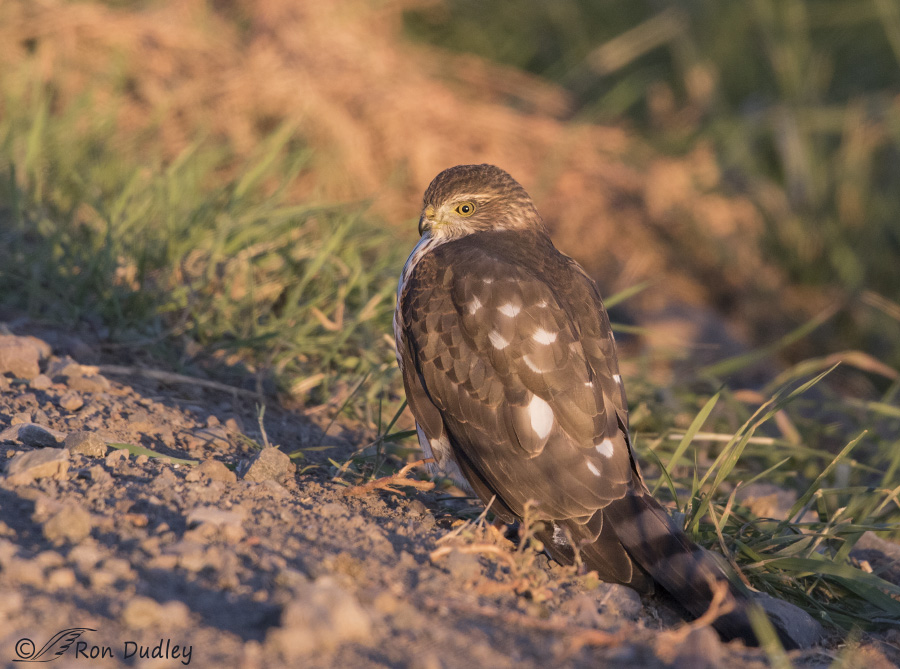
1/1000, f/6.3, ISO 1600, Canon 7D Mark II, Canon EF500mm f/4L IS II USM +1.4, not baited, set up or called in
Here the hawk is mostly resting again along the road edge but I could tell by its demeanor and posture that it was almost constantly scanning the trough for potential prey.
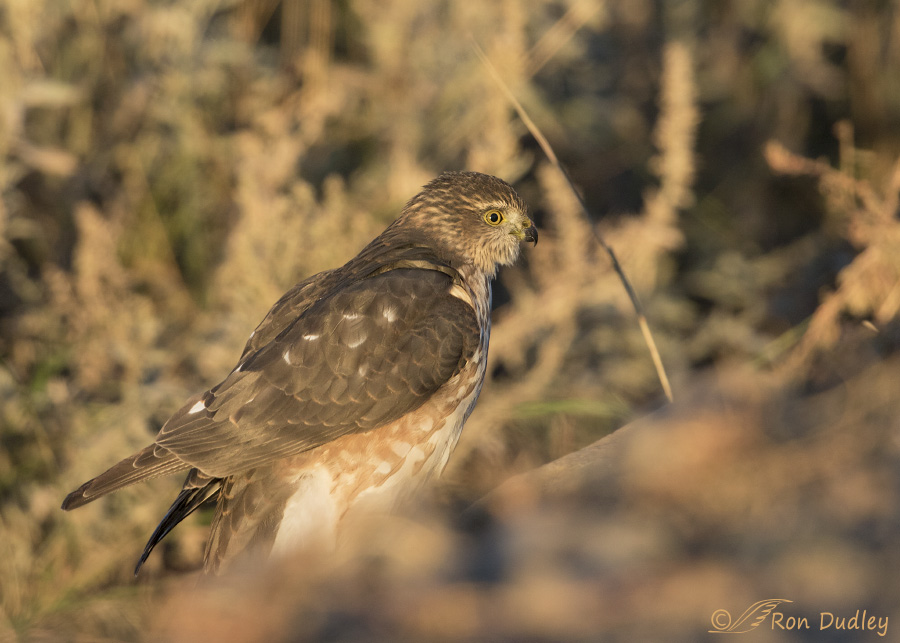
1/1000, f/6.3, ISO 1000, Canon 7D Mark II, Canon EF500mm f/4L IS II USM +1.4, not baited, set up or called in
Another rest stop. I include this photo because it shows how steep the trough is (the bird is standing on the edge of it and it extends to the upper right in the photo).
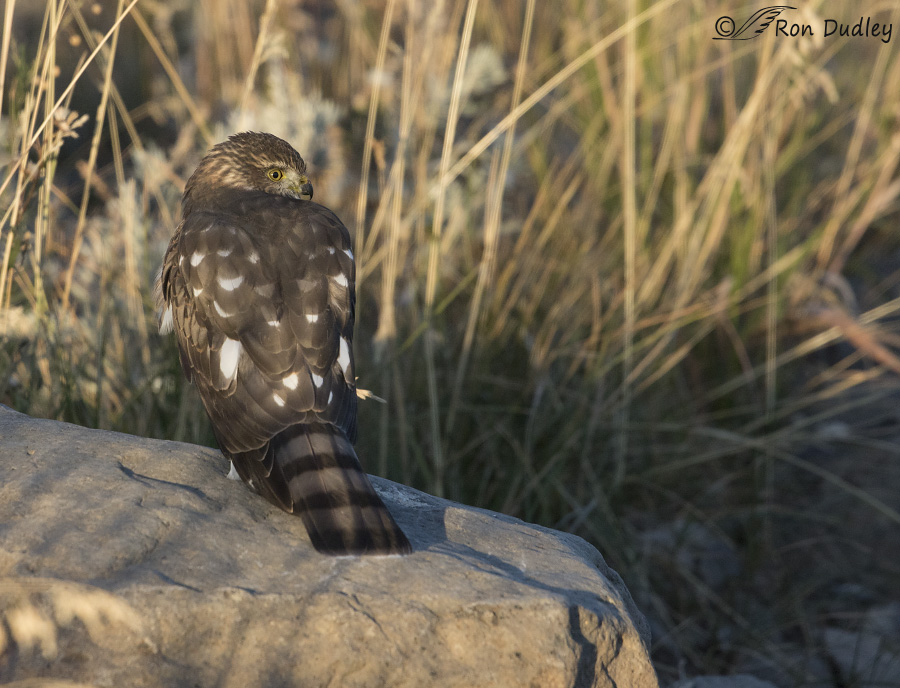
1/800, f/8, ISO 1000, Canon 7D Mark II, Canon EF500mm f/4L IS II USM +1.4, not baited, set up or called in
This time its resting spot is a rock, again on the edge of the trough which extends in the direction the hawk is looking (and hunting).
At this point I moved on down the road and let the bird hunt in peace. I don’t remember seeing this bird again for exactly five days.
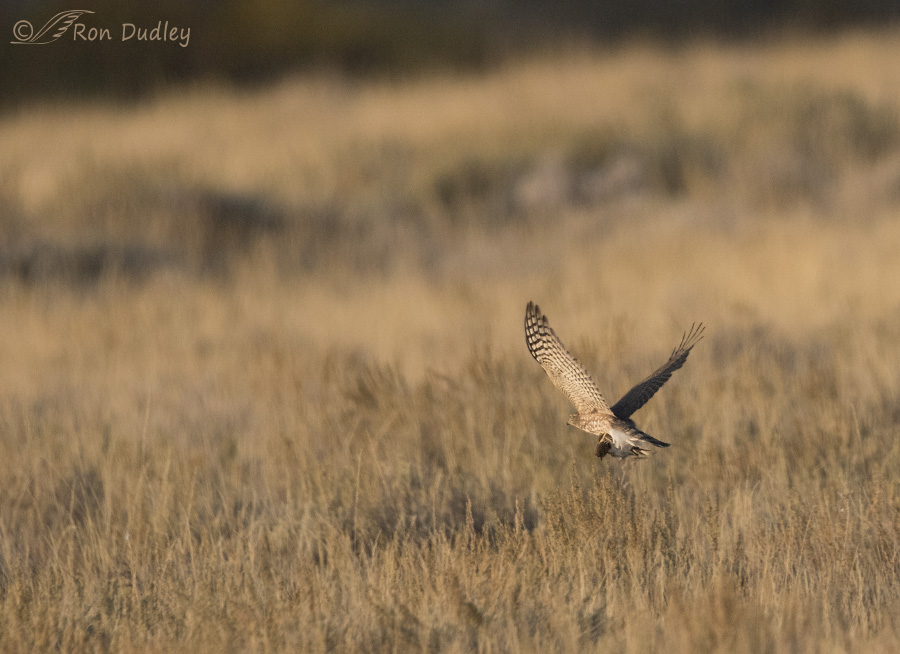
1/3200, f/5.6, ISO 1600, Canon 7D Mark II, Canon EF500mm f/4L IS II USM +1.4, not baited, set up or called in
But on the morning I left the valley and headed home I found it again. And yup, it was hunting the trough again but this time it was on the right side of the road and it already had prey. I didn’t see it until it flew out of the trough and across the road in front of me. I was pulling the camping trailer so it took me a little extra time to get stopped and I fired off a few shots from far away as it disappeared to the south. The fact that it had prey and flew out of the trough is evidence of the effectiveness of this apparently tried and true hunting technique.
I wish I had taken photos of the hawk hunting the trough. I could have done it but at the time my goal in this low light was high quality perched shots rather than documentary images of hunting behavior in flight.
Maybe next time…
Ron


Hi Ron, I followed your narrative while visualizing the long toes of this young male (I think) pulling a small bird out of the undergrowth along the trough… but it appears to be a vole(?!) Is that indeed the case? How un-Sharpie like if it is! However, I’m looking at the pic on my phone while at Goshute and could be wrong. Btw- we’re in the middle of the annual accipiter push and Sharpies (in particular), as well as Coops and Gos are raining from the sky. A couple of years ago a female SS come in with a chipmunk tail still impaled on her talon, but in general, the sight of mammalian prey in the feet of these little warriors is surprising. And cool.
Mike, At first I also thought it might be a vole and that surprised me so I cropped in on the image big-time and I do believe it’s a bird, one larger than a sparrow. I’ll email you the cropped version to see what you think.
Sounds like you’re having a blast on the mountain. Loved hearing about the “raining” accipiters!
Ron, thanks for the continuing education. I never thought that hawk can & do rest on the ground. Always thought of them on post, power poles, etc. Great pictures
Thanks
David
Innovative and clever. I am very glad to see and hear it was also successful. Bird-brained? I can think of a person or six who would be vastly improved…
Agreed, EC. I just hope this bird doesn’t have an encounter with a vehicle going too fast on this road…
Fascinating technique this bird has. I used to see a Sharpie in my early years in Richmond; it would appear on rainy days sitting in a dogwood tree just over my back fence. It’s nice to see what they look like up close, because I never did get a close look at the one who visited my yard. (Back then I had bird feeders, and was new to really enjoying birds, so I probably didn’t fully appreciate why the Sharpie visited…)
Yup, your bird feeders were feeding more birds than you thought, Susan!
When I have feeders out I seldom get any sharpies but I do occasionally get Cooper’s.
Hi Ron, I used to see sharpies using this technique as they hunted the former Skaggs Island Navy Base (after base closure, it is now part of San Pablo Bay NWR). The property consists of a couple of thousand acres criss-crossed with LOTS of dikes and ditches, some of which replicate your trough exactly. I had the same reaction you did when I first encountered the technique, but then I began to look for the birds every time I led an outing there. I also observed the hawks using the ditches as ambush approaches in order to hunt birds that were in trees located in the middle of open habitat. It worked.
Try this for Dick’s column
http://www.eastviewatmiddlebury.com/files/Pages/News/2A.AUGUST%2015_%20FIELD%20NOTES%20copy%202.pdf
BTW, Cornell has an EXCELLENT page on differentiating sharpies vs coops. And, they generously gave me permission to use their material for my hawk ID class (with acknowledgement, of course). Toughest ID problem in NA hawk ID, in my humble opinion…
Cheers,
Dick
Ok, thanks very much, Dick. That link worked.
Interesting to know that you’ve seen sharpies using the same technique. This was the first time for me.
As you probably know I’m a huge fan of the Cornell lab, particularly their Birds of North America Online.
And here is the link to the Cornell page: http://feederwatch.org/learn/tricky-bird-ids/coopers-hawk-and-sharp-shinned-hawk/
Cheers!
That’s an excellent comparison of field marks. This statement explains the confusion in distinguishing the two species very well.
They’re so similar that “no single field mark is likely to distinguish one species from the other”
Very interesting about the hunting technique. Clever birds.
Yes, they are, Arwen – especially considering the fact that this one is only a juvenile (I believe).
Great shots Ron. Just wrote a Nature Notes column with a segment on Sharp-shinned Hawk compared to Cooper’s Hawk. These pictures show what I tried to describe. Very nice series!!
Thank you, Dick.
I often have a hard time telling the two species apart. Is there a link to your column? If so, I’d like to see it and I’ll bet some other folks would too…
Yes!
Thank you Ron and Patty, here is the link. http://www.eastviewatmiddlebury.com/eastview-bird-list.jsp
Background: This is a new facility as of 2012. It is developed poor land, BUT overlooks about 500-700 acres of meadow, field, and farmland, with the Green Mts in the background to the east, a section of woods next to Otter Creek which is fairly near to us, so some of the field is damp with Canary Grass, Cattails, etc. We also have two retention ponds, one of which is in our back yard. Excellent opportunity to keep track of what happens nature wise to this new area.
Need to leave for the day. But, if anyone has any questions, please don’t hesitate to ask. raharlow@comcast.net
Dick, I’m not finding your column about Sharpies/Cooper’s in that link – probably just not smart enough… If anyone else finds it please let me/us know.
MY ERROR!!! Has nothing to do about not being smart enough! I had notes on a Cooper’s, (August 15-30) not the Sharpie because I’m writing that now and it will be submitted the end of the month. My wife is the editor of what I write and I gave it to her several days ago, so it was fairly fresh in my mind! Remember, I’m an old guy. So sorry about that, didn’t realize what I had done till I was 30 miles down the road and didn’t have a way to get back to the computer to let you know. This article compares behavior from my personal experience, e.g. the no neck, or scrunched down neck of the Sharpie compared to a neck for the Cooper’s. Also, I have had Cooper’s mantel their kill with me not far away, and when I get close enough they will fly a short distance watching to see what I will do. Step away to a safe distance and the Cooper’s will come back. To me they are fearless. A Sharpie, at least around here will make a kill here, fly to the woods 500-800 yards away and eat it. Not going to hang around humans. That is why, in my mind, you had a special treat with this Sharpie.
As you already know Cornell is a good resource. I was simply talking about what people have seen here and what they could expect to see in the future.
DICK!!! You take some WONDERFUL photos!!! I very much enjoyed them, along with the article on ACCIPITERS. As a bonus, I also discovered your beautiful photo of the Pond Bluet! A wonderful reminder of a time spent with a small boy while camping with Lakota friends in the Rockies. The boy, about 10, took me to his “special place”, a truly magical pond where the air was filled with hodes of magical, cobalt Bluets,skimming over the wayer and through the weeds, their rich, iridescent colors making the air sparkle like fairy dust… their delicate bodies and wings shimmering in the late afternoon sun. It was his secret…and I kept it….
Thank you so much Patty!
Wonderful words from an artist, have you stayed in touch with this young boy?
I have a very dear friend who is friends with both the Blackfeet and Lakota nation.
No! I was unable to communicate with him. HIs sindle-parent mother had no phone, no stable address….livingva ptetty nomadic life…wish I had been able to…might have been a link he neededvand I would have enjoyed.
Interesting observations and comments…glad to see a juvenile with a polished techniques…so many young ones die of starvation because they don’t have polished hunting skills. Looks like this one is carrying a vole….bet they like those ditches, too.
I thought it was a vole at first too, Patty but when I cropped in extremely tightly it appears to be a bird larger than a sparrow. Can’t tell positively though, I was just too far away.
Thought I saw a vole tail…I can only tell Sharpies from Coopers when they sit side-by-side (which they never do!)…the Coopers are a little bigger and the Sharpies have skinnier legs, otherwise, forget it!!!
With such deep drop-offs on either side and what looks like such a narrow road, passing, esp. towing a camper, must be harrowing! Would hate to try to pass one of those monster RV’s, especially one driven by an inexperienced, distracted tourist!!!…..
Yes, it can be harrowing at times but mostly it’s not a problem because there’s not much traffic on the road. Logging trucks and cattle trucks do get my attention though, especially when I’m pulling the camping trailer.
But the dust is simply incredible! I can’t even tell what color my pickup really is when I get home, inside or out. Typically, after washing it, my technique of cleaning the inside is to open all four doors and spend a half hour blowing as much of the dust out of the interior as possible with my air compressor – looks like a dust storm! Then the real cleaning begins…